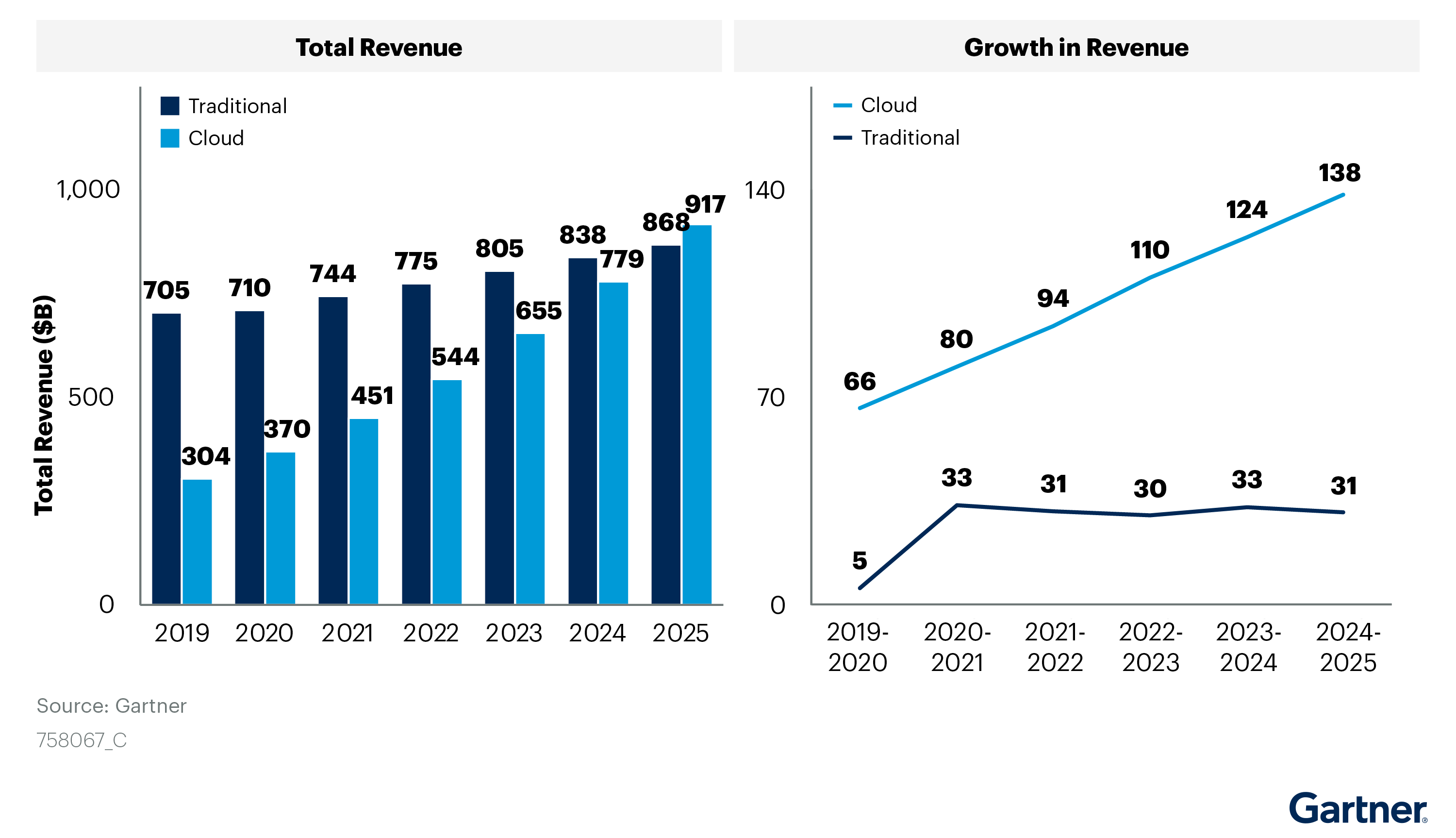Embracing Cloud Marketplaces: The New Frontier for IT Procurement and Sales

A significant trend is reshaping how businesses procure and invest in cloud solutions: the rise of cloud marketplaces. This shift is particularly relevant for Independent Software Vendors (ISVs), who are finding these marketplaces to be not just another sales channel, but a critical element in their go-to-market (GTM) strategies.
Cloud computing, and purchasing solutions from marketplaces, is not just an option but a necessity. Understanding and adapting to these changes is more crucial than ever for ISVs looking to maintain a competitive edge and capitalize on the opportunities that lie ahead. This article aims to explore the changing dynamics of IT spending, the challenges and opportunities we see for ISVs, and strategies to effectively navigate the shift towards cloud-based solutions.
The Rise of Cloud Marketplaces
The Shift in IT Spending
According to Gartner’s research, the projection is that public cloud IT spending will surpass traditional IT expenditures by 2025. This shift is expected to be particularly pronounced in sectors encompassing application software, infrastructure software, business process services, and system infrastructure.

Consequently, by 2025, it is anticipated that over half (51%) of the spending within these market categories will have transitioned from conventional IT solutions to public cloud alternatives, reflecting a notable increase from the 41% reported in 2022.
This evolution in spending patterns represents a substantial market opportunity for ISVs, especially in segments intricately linked to infrastructure, which are poised for robust growth as cloud adoption continues to surge. In this evolving landscape, cloud marketplaces like those offered by AWS, Azure, Google, Salesforce, and Oracle are becoming increasingly prominent.
The Growing Cloud Marketplace
Tackle.io predicts robust growth in the cloud marketplace, with expectations of exceeding $10 billion in transactional throughput by the conclusion of 2023 and an ambitious projection of reaching $50 billion by the culmination of 2025. ISVs are slated to play a pivotal role in this market expansion, generating substantial revenue through AWS, Azure, Google, Salesforce, Oracle, and other emergent cloud platforms.
Five Strategic Advantages of Cloud Marketplaces for ISVs
1. Activates a Lucrative Sales Channel
Cloud marketplaces offer a streamlined path to market, reducing the complexities often associated with traditional sales channels. This approach can significantly enhance deal velocity and customer reach.
2. Aligns with Existing Routes to Market
Integrating cloud marketplace strategies with traditional sales approaches allows ISVs to cater to a broader range of customer preferences and buying behaviors.
3. Creates an Efficient Procurement Process
For customers, purchasing through cloud marketplaces simplifies the procurement process, offering a more efficient and user-friendly experience.
4. Offers Co-Selling Opportunities
Partnerships with cloud providers in these marketplaces open doors for co-selling opportunities, leveraging the provider's sales force for wider market exposure and potential revenue growth.
5. Increases Visibility and Customer Access
Being present in cloud marketplaces increases an ISV’s visibility to potential customers, especially those who prefer cloud solutions for their scalability and flexibility.
READ MORE: Best practices to succeed as a marketplace seller
Navigating the Transition to Cloud Marketplaces
For ISVs, the transition to leveraging cloud marketplaces involves several key steps:
Begin With Strong Vision and Sponsorship
First, developing a solid vision and strategy for the transition is imperative. With the shift to ARR, there is a broad impact on compensation and corporate revenue recognition that often impacts short-term revenue growth, even with robust customer acquisition and expansion. It is particularly important that all levels of corporate leadership buy into the shift and are the leaders to create change. Ensuring the CRO, CPO, and CMO are all aligned is essential to drive growth in your cloud marketplace offerings.
Develop Your Offers
Develop an integrated and rationalized set of offerings across cloud and on-premises solutions that are easy for customers to understand. Additionally, you need to understand your customers' marketplace experience and optimize it to support the customer lifecycle. As you develop solutions, you must consider how customers research and evaluate your software in a marketplace scenario and provide the appropriate demos, test sandboxes, and purchasing scenarios. Finally, you will need to develop a strategy for transactable offers (click to buy) versus private offers that need to be negotiated directly.
Prioritize an Integrated Approach
Once the offerings are available, you then need to develop and integrate the messaging for your new cloud-based products and your existing set of products. Many companies stall at this point and add the new cloud-based products as a separate product line. When discussing the value, they delay the efficiencies of treating the cloud-based solutions as equal to their on-premises products. This often needs to be clarified for customers, and the marketplace-only customers do not hear the cloud-based message they need to gain interest in your product line.
Create a Functional Activation Strategy
Initially, many ISVs view the Marketplace products as a “Partner” motion via their Strategic Alliance partner team, much like they treat the distributor/var channel. This works while you are working through the initial marketplace strategy and engagement. Still, once you get through this startup, it is essential to transition from an alliance-driven approach to a company-wide activation strategy that elevates the role of the cloud as an equal pillar in all business operations, with active C-suite endorsement and engagement, especially the CMO who plays an important role in the sponsorship and engagement of these motions. Each area needs a plan and timeline to begin activating its customer engagement strategy for the new customer requirements that come with a cloud product. All elements of demand generation, selling, customer success, and partner ecosystem need a plan and a timeline for activation.
Elements of Functional Activation Strategy
- Sales Activation: When considering sales team activation, it is critical to take an end-to-end approach, including key aspects such as compensation realignment to balance traditional and cloud revenue, extending sales enablement, determining whether cloud sales are distributed throughout the team or handled by a specialized sales unit, optimizing the cloud deal desk for faster sales cycles, formulating approaches for collaborating with cloud provider sellers in a co-sell motion, and adopting a systems approach for sharing leads and opportunities.
- Full GTM Execution: Adding marketplace and cloud capabilities enables you to expand the routes you use to interact with your customers. Key GTM aspects encompass renewals and upselling, particularly directing them toward cloud-based solutions. Demand generation focusing on cloud-enabled solutions allows you to attract new customers through a choice-driven model, driving more leads and opportunities with a broader set of customers and x-sell and/or upsell scenarios.
- Channel Activation: Bringing your channel with you is essential. They see the same technology and purchasing shifts that the industry is going through, and they will want to be in front of the trend. Driving enablement, partner programs, and incentives to embrace and accelerate cloud adoption are essential. Having robust operational control of deal registration, co-marketing, and co-selling is important as you add the incremental operational complexity of transacting via the marketplaces and co-selling with cloud providers’ sales teams.
Maximizing Opportunities in the Cloud Marketplace Era
The shift towards cloud marketplaces represents a pivotal change in how IT solutions are procured and sold. For ISVs and born in the cloud companies, understanding and adapting to this shift is critical. By strategically embracing cloud marketplaces as part of their GTM strategy, ISVs can unlock new sales channels, streamline procurement processes, and ultimately drive growth and success in the cloud-driven marketplace.
At Bridge Partners, we are committed to helping our clients navigate the complexities of the cloud marketplace. With our deep expertise in partner ecosystems and alliances, we enable ISVs to maximize the impact of their partner channels and adapt to the rapidly changing cloud landscape. Discover how we can empower your ecosystem and drive success in this new era.
READ MORE: Plan of Action Checklist: Equipping Your Partner Program for Success
Empower Your Ecosystem with Bridge Partners
We unlock the enormous value your partner ecosystem represents by elevating partner programs, enabling the channel, and accelerating pipelines. Our unmatched experience in partner ecosystems and alliances helps you maximize the impact of your partner channel. See how we can help you.
About the author



